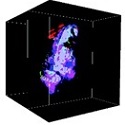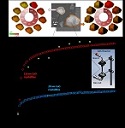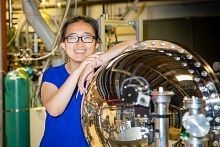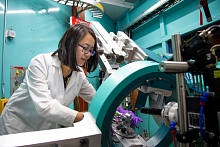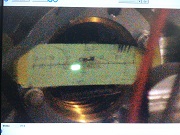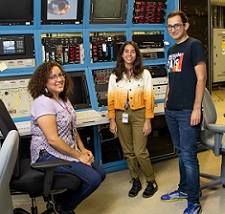Vol. 19, No. 2 - August 2018
View the Archives

Science Highlights ________________________________________
Empowering Multicomponent Cathode Materials for Sodium Ion Batteries by Exploring Three-dimensional Compositional Heterogeneities – Contacts: Yijin Liu, Dennis Nordlund, Dimosthenis Sokaras (SSRL) and Feng Lin (Virginia Tech) Lithium ion batteries are widely used in electronic devices and vehicles because of their high energy density. Unfortunately, lithium is not an abundant element on Earth, so demand is mounting for an alternative battery that has high energy density but made with more sustainable materials. Read more…
Direct Observation of the Kinetics of Gas-Solid Reactions Using in-Situ Kinetic and Spectroscopic Techniques – Contacts: Yijin Liu, Simon Bare (SSRL) and Dante Simonetti (UCLA) Hydrogen sulfide (H2S) is a poisonous and corrosive gas created in industrial and natural systems. Copper oxide (CuO), a crystalline solid, can be used to clean H2S from emissions by forming various copper sulfide species, a reaction that is thermodynamically favorable but often does not go to completion in industrial applications. Read more… SSRL/LCLS Users' Meeting - September 25-28, 2018 _____________Our Annual SSRL/LCLS Users' Meeting is approaching fast. Please help to spread the word – encourage your colleagues to register to attend and present a poster to share their latest results or new capabilities. September 18 is the deadline for online registration and poster abstract submission. Promote your poster at the Poster Blitz and compete for Joe Wong Outstanding Poster Awards. More details are available at the Meeting website. The September 26 and 27 plenary sessions will include a welcome from SLAC Director Chi-Chang Kao, an update by Harriet Kung (DOE BES), updates by facility directors Kelly Gaffney and Mike Dunne who will also lead a town-hall discussion, and invited talks by Eric Lin (NIST), David Reis (Stanford), Junko Yano (LBNL), and Peter Weber (Brown University). Workshops will be held on each day, covering the following topics:
Vote for UEC Membership
The SSRL Executive Committee (UEC) provides an organized framework for interaction between the scientific user community and SSRL/SLAC Management to communicate the interests of users regarding SSRL operations and user support. The UEC meets several times a year and includes representatives from various scientific areas utilizing SSRL beam lines. Elected UEC members generally serve three-year terms and elections are held each fall as some of the members rotate out. This election is held in conjunction with the Annual Users' Conference. Please take a few minutes to review the candidates and cast your ballot for the 2018/2019 SSRL UEC. Vote: SSRL UEC Ballot Honors and Awards _______________________________________Ming Yi to Receive Spicer Award Excerpt from July 30, 2018 SLAC Today article by Miyuki Dougherty
In recognition of her foundational superconductor research, Ming Yi, Assistant Professor of Physics and Astronomy at Rice University, will be awarded the 2018 William E. and Diane M. Spicer Young Investigator Award. Ming says the award is of special significance to her because she thinks of Bill Spicer as her academic grandfather. A Stanford professor of 40 years and researcher in electrical engineering, applied physics and materials science, Spicer co-founded the Stanford Synchrotron Radiation Project in 1972, which became SSRL. Spicer actively mentored students until his death in 2004. “This is a very humbling honor for my scientific endeavors as I continue my academic career, and I deeply appreciate SSRL’s commitment to nurturing young researchers in the frontiers of scientific exploration,” Yi says. “I am very grateful to all the mentors who have given me advice, support and encouragement, and who have inspired me and still inspire me every day.” Read more… Chuntian Cao Wins 2018 Klein Award for Lithium-ion Battery Research Excerpt from August 30, 2018 SLAC Today article by Ali Sundermier
Chuntian Cao has been selected to receive SSRL’s 2018 Melvin P. Klein Scientific Development Award. The Klein award recognizes outstanding research accomplishments by undergraduates, graduate students and postdocs within three years of receiving their Ph.D. who used SSRL for their research. Established in 2006 by the SSRL Users’ Executive Committee, the award honors the late Melvin P. Klein, a biophysicist and pioneer in the field of spectroscopic methods, including x-ray absorption spectroscopy. Chuntian has been recognized for her research using x-rays to map silicon as it cycles within a battery. She is especially interested in silicon-based batteries. Although silicon has much higher capacity than other battery materials, meaning it can hold more charge, there are obstacles that researchers need to overcome to make the material more stable before using it in devices. “Our goal is to improve our fundamental understanding of how this material works, which in turn could lead to safer batteries that can function more efficiently and last longer,” she says. Read more... Beam Line Updates _______________________________________Beam Line 12-1 Courtesy of Dan Harrington
We have obtained first light at BL12-1! This beam line is the sister of BL12-2 and will support macromolecular crystallography experiments, with emphasis on the analysis of very small samples. Taking advantage of the experience gained operating the BL12-2 small gap in-vacuum undulator (IVU), the new BL12-1 IVU has been designed for smaller magnet gap allowing the incorporation of 162 poles, compared to the 134 poles achieved with the same length BL12-2 IVU insertion device. This higher brightness source is teamed with state-of-the-art Kirkpatrick-Baez (KB) mirrors, the well-established SSRL LN2-cooled monochromator design, and multilayer capabilities. The optical system is designed to maximize source demagnification, yielding a focus optimally sized for crystallography of ≤5µm samples with beam stabilization servo systems to ensure stable illumination of small samples. The hutch equipment will include the evolving SSRL SMB macromolecular crystallography instrumentation for micro-crystal applications and a state-of-the-art Dectris Eiger x-ray detector. There is still a significant amount of installation and commissioning work to be done before the beam line is ready for user experiments, and this effort will continue into the fall when SSRL resumes user operations after its annual summer shutdown. Beam Line 16-2 Courtesy of Matt Strader BL16-2 is undergoing commissioning! This beam line is a soft x-ray metrology beam line capable of delivering a variably-focused beam using a bend magnet source. Design emphasis has been placed on strong suppression of higher harmonics resulting in a moderate-resolution beam of high harmonic purity spanning an energy range of 50 – 2400 eV. These beam characteristics are useful in performing diagnostics of samples and instrumentation in support of the NNSA research priorities. There is still some commissioning remaining as user experiments commence, specifically including testing of the harmonic rejection mirror system, and this effort will continue into the fall when SSRL resumes user operations after its annual summer shutdown. SSRL-Related News _______________________________________Hot Science with Cool Sensors Excerpt from August 1, 2018 Physics Today article by Kelsey Morgan A thin superconducting film on the edge of the transition between its superconducting and normal states makes an ultrasensitive thermometer, capable of measuring the energy of individual x-ray and gamma-ray photons. The transition-edge sensor (TES), like superconducting transmission lines and superconducting magnets, dates back to the late 1930s. But like so many of the early ideas for applications of superconductivity, it would take decades of innovation in theory, electronics, microfabrication, and cryogenics for the TES to realize its potential. Today a TES array at SSRL measures the x-ray absorption spectra of delicate biological molecules as they undergo complex chemical reactions. We have entered an era where we don’t just study superconductivity; we use the superconducting phase transition as a tool for scientific discovery. Read more… Students Affected by Hurricane Maria Bring their Research to SLAC Excerpt from August 21, 2018 SLAC Today article by Ali Sundermier
Last fall, five researchers from Puerto Rico had the opportunity to travel to SLAC as part of an internship program designed to give students affected by Hurricane Maria a chance to conduct research using the SSRL's user resources and the cryo-electron microscopy (Cryo-EM) center. The internship program, funded by SSRL and the BioXFEL National Science Foundation Science and Technology Center, was spearheaded by SSRL scientist Aina Cohen with help from SLAC’s student program advisor Enrique Cuellar, BioXFEL director Edward Snell and BioXFEL Education and Diversity director Bill Bauer. Cuellar and Cohen wanted to provide the students with the space and facilities they needed to continue working on their projects. After Cuellar secured additional funding from work2future, a local nonprofit organization, the students were able to return to SLAC once again this summer. Read more… Workshop Summary ______________________________________Courtesy of Kevin Stone The hard x-ray scattering group at SSRL organized a July 16-18, 2018 summer school on synchrotron scattering techniques. The workshop included one and a half days of lectures on the theoretical, experimental, and practical aspects of the scattering techniques used at SSRL beam lines. SSRL scientific staff and engineers introduced the basics of scattering theory and reciprocal space, especially as they relate to scattering experiments at SSRL beam lines. The basics of conducting scattering experiments were covered, from beam time proposals, sample preparation and beam line choice, to data collection strategies and analysis. The first day and a half of lectures were followed by hands on instruction at four different scattering beam lines where participants learned how best to prepare samples and how to operate the beam lines for data collection. The final afternoon consisted of hands-on data analysis instruction, where participants were taught how to analyze data as it would have been collected from the hands-on sessions at the beam lines. The school was attended by 27 participants from a number of institutions including international participation, and 18 of these attendees participated in the hands-on sessions. The school was supported by DOE-BES. Upcoming Events and Courses _______________________________
User Research Administration _______________________________SSRL Beam Time Request Deadline
SSRL Proposal Deadlines
See SSRL Proposal & Scheduling Guidelines and submit proposals and beam time requests through the User Portal. _____________________________________________________________________ The Stanford Synchrotron Radiation Lightsource (SSRL) is a third-generation light source producing extremely bright x-rays for basic and applied research. SSRL attracts and supports scientists from around the world who use its state-of-the-art capabilities to make discoveries that benefit society. SSRL, a U.S. DOE Office of Science national user facility, is a Directorate of SLAC National Accelerator Laboratory, operated by Stanford University for the U.S. Department of Energy Office of Science. The SSRL Structural Molecular Biology Program is supported by the DOE Office of Biological and Environmental Research, and by the National Institutes of Health, National Institute of General Medical Sciences. For more information about SSRL science, operations and schedules, visit http://www-ssrl.slac.stanford.edu. To unsubscribe from SSRL Headlines, just send an e-mail to listserv@slac.stanford.edu with "signoff ssrl-headlines" in the body. To subscribe, send an e-mail to listserv@slac.stanford.edu with "subscribe ssrl-headlines" in the body. Questions? Comments? Contact Tomoko Nakai or Lisa Dunn
|

